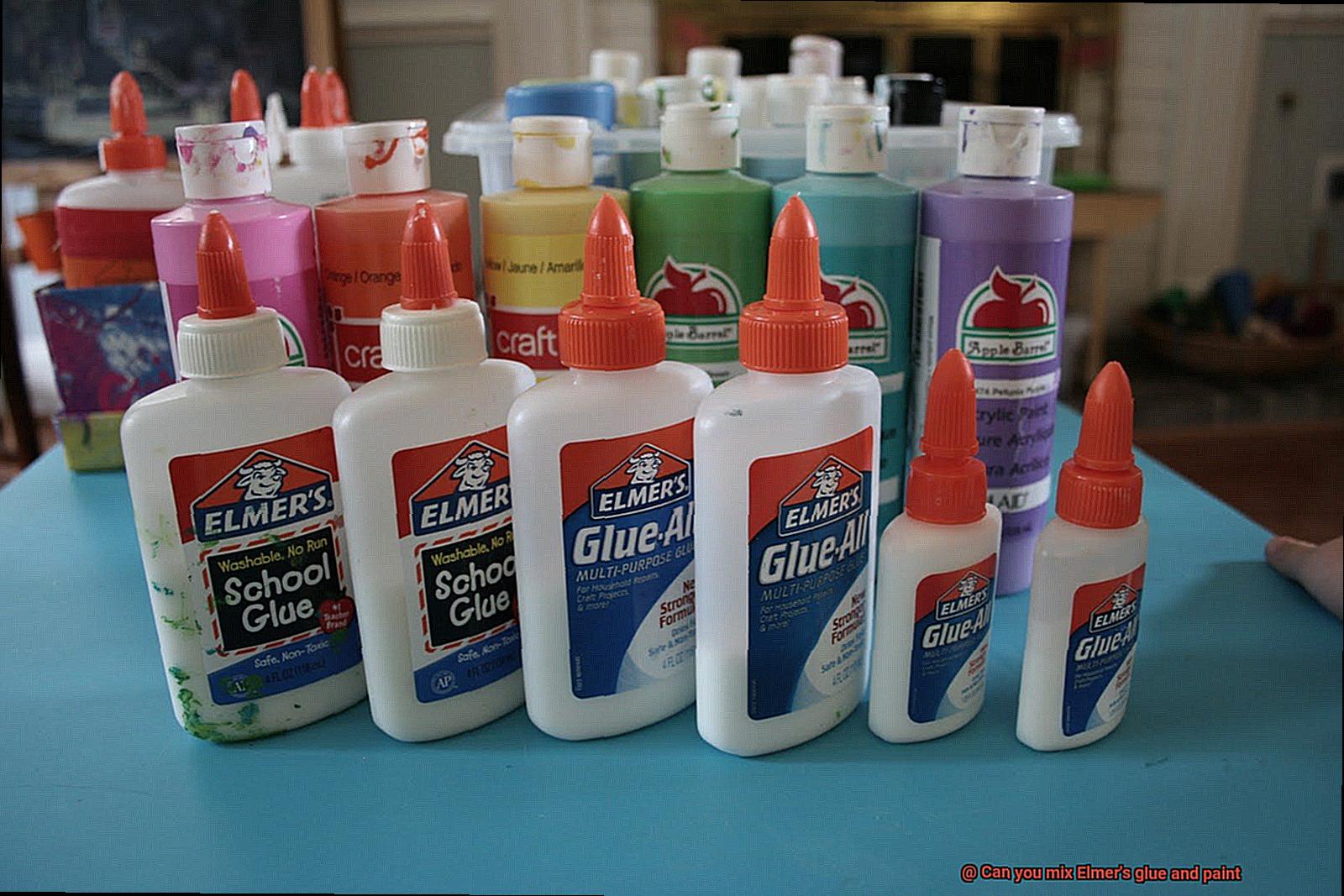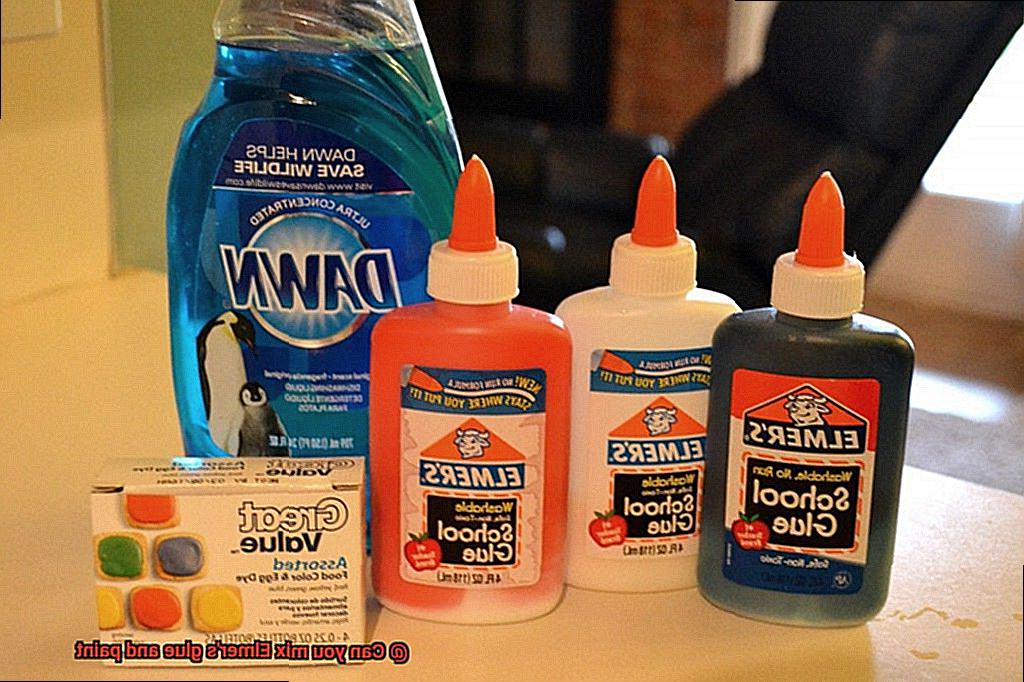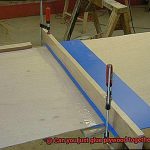Are you tired of your artwork looking flat and lifeless? Want to add some pizzazz to your next project? Mixing Elmer’s glue and paint might just be the solution you’ve been searching for.
By combining Elmer’s glue and paint, you can produce a range of fascinating effects that will take your artwork to the next level. From creating a glossy finish to adding a 3D texture, the possibilities are endless. But before you start mixing away, there are a few things you need to know.
Firstly, not all paints work well with Elmer’s glue. Watercolors or acrylics can dilute the glue and result in an ineffective mixture. So be sure to select the right type of paint for your desired effect.
Secondly, it’s crucial to measure the ratio of glue to paint precisely. Too much of either ingredient can lead to a lumpy or uneven mixture, or even cause cracking or peeling over time.
Lastly, keep in mind that this technique isn’t permanent. Over time, the glue may yellow or deteriorate, affecting the appearance of your artwork and potentially causing damage.
In conclusion, mixing Elmer’s glue and paint is an exciting way to add depth and texture to your artwork. Just remember to use the right type of paint, measure carefully, and enjoy experimenting with this fun technique.
What is Elmer’s Glue?
Contents
- 1 What is Elmer’s Glue?
- 2 Can You Mix Elmer’s Glue with Paint?
- 3 What Type of Paint Should You Use?
- 4 What Are the Benefits of Mixing Elmer’s Glue and Paint?
- 5 What Are the Proportions for Mixing Elmer’s Glue and Paint?
- 6 How to Use the Mixture of Elmer’s Glue and Paint
- 7 Different Types of Art Projects Using Elmer’s Glue and Paint
- 8 Tips for Creating Unique Colors and Effects with Elmer’s Glue and Paint
- 9 Conclusion
Elmer’s Glue is a beloved brand of white, water-based adhesive that has become a staple in households and classrooms worldwide. Its unique combination of polyvinyl acetate (PVA) and water gives it its characteristic white color and allows it to stick to any surface with ease.
What sets Elmer’s Glue apart from other adhesives is its quick-drying properties and strong hold, making it a reliable choice for a variety of applications. Elmer’s Glue was first introduced in 1947 by the Borden Company, and since then, it has become a household name in the United States and around the world.
The brand has expanded its product line to include clear glue, glitter glue, and other specialty formulas for different types of projects, such as spray adhesives and glue sticks. These products have only added to the versatility of the brand.
One question that people often ask about Elmer’s Glue is whether it can be mixed with paint to create unique colors and effects. The answer is yes. When mixed together, the glue and paint create a thicker, more textured consistency that can be used for a variety of art projects. This mixture is commonly referred to as “paint glue” or “glue paint.”
It is important to note that not all types of paint are compatible with Elmer’s Glue. Acrylic paint, which is also water-based, is the best type of paint to mix with Elmer’s Glue. Other types of paint, such as oil-based or enamel paints, may not mix well with the glue and could result in a poor-quality mixture.
When mixing Elmer’s Glue with acrylic paint, it is important to use the right proportions of each. A general rule of thumb is to use one part glue to two parts paint. This will create a thick consistency that can be applied to a variety of surfaces.
Can You Mix Elmer’s Glue with Paint?
There are some crucial things to keep in mind before getting started.
Firstly, the type of paint you’re using is critical. If you’re working with water-based paints like acrylics or tempera, then mixing them with Elmer’s glue can enhance the texture and durability of your artwork. However, if you’re using oil-based paints, it’s best to avoid mixing them with glue as it may not work well and could ruin your artwork.
The quantity of glue you mix with your paint is also vital. Mixing too much glue can make the paint too thick and challenging to work with, while too little may not have any effect on the texture or durability of your artwork.
Lastly, it’s crucial to remember that Elmer’s glue cannot replace proper painting mediums or binders. While it can enhance certain properties of your paint, relying solely on it as the medium for your artwork is not recommended.
In conclusion, mixing Elmer’s glue with paint is possible and can bring some benefits to your artwork. However, moderation is key. It’s best to start with a small amount of glue and test before committing to a larger project. By considering these factors, you’ll be able to create unique and textured pieces that stand out from the rest.
What Type of Paint Should You Use?
As an expert in this field, I am here to provide some valuable insights on the best paint types to use when mixing with glue.
Acrylic paint is a popular choice for mixing with glue due to its water-based formula. It is easy to mix and clean up, dries quickly, and has a flexible finish, making it perfect for mixed media projects. So, if you’re looking for a versatile and reliable paint option, acrylic is your best bet.

On the other hand, oil-based paints are not recommended for mixing with glue. They contain solvents that can break down the glue and cause it to lose its adhesive properties. Plus, they take longer to dry and can be quite challenging to clean up.
Another fantastic option is tempera paint, which dries quickly like acrylic paint but has a matte finish that can add a unique touch to your artwork. This water-based paint is a popular choice for children’s art projects and can be easily mixed with glue to create a homemade decoupage medium.
What Are the Benefits of Mixing Elmer’s Glue and Paint?
Look no further than mixing Elmer’s glue and paint. This popular technique has several benefits that can take your artwork to the next level.
Firstly, combining Elmer’s glue with paint thickens the paint, making it easier to control and enabling you to create intricate designs. The thicker consistency allows for more control over brushstrokes, creating a smoother and more even coverage.
Secondly, mixing glue with paint provides a glossy finish that adds dimension to your painting. This effect is particularly noticeable when using metallic or glitter paints, which can give your artwork an extra sparkle and shine.
But the benefits don’t end there. By combining glue and paint, you can also improve the longevity of your artwork. The glue acts as a binding agent, helping the paint adhere better to the surface and preventing cracking or flaking over time. This ensures that your artwork remains vibrant and intact for years to come.
And let’s not forget about the affordability factor. Glue is readily available at most craft stores and is much cheaper than other specialized mediums like gesso or modeling paste. This makes it an accessible option for artists on a budget who want to experiment with different techniques.
What Are the Proportions for Mixing Elmer’s Glue and Paint?
Mixing Elmer’s glue and paint can add a new dimension to your creations, but getting the right proportions is crucial to achieving the desired consistency and properties.
The recommended proportion for mixing Elmer’s glue and paint is one part glue to one part paint. This means that for every cup of glue, you should mix it with one cup of paint. However, this ratio can be adjusted based on your desired outcome.
For a thicker mixture, use more glue than paint. A ratio of two parts glue to one part paint will provide a thicker consistency. Conversely, if you want a thinner mixture, use more paint than glue. A ratio of one part glue to two parts paint will give you that thinner consistency.
It’s important to note that different types of paint and glue may require different proportions. Therefore, it is advisable to create a small test batch first. Mix a small amount of glue and paint together and adjust the proportions until you achieve the desired consistency.
Whether you are looking for glossy finishes or extra sparkle and shine, mixing Elmer’s glue and paint can help you achieve it without breaking the bank. So why not experiment with different proportions to create your next masterpiece?
How to Use the Mixture of Elmer’s Glue and Paint
Look no further than the mixture of Elmer’s glue and paint, a versatile substance that can enhance your work in many ways. By following a few simple tips and tricks, you can create unique textures and colors that will make your projects stand out.
Ratio of Glue to Paint
To start with, it’s essential to note that the ratio of glue to paint varies depending on the type of project and desired outcome. A 1:1 ratio of glue to paint is a good place to start. Pour equal parts of both into a mixing container and stir until fully combined. Use a container large enough to accommodate both substances without overflowing or making a mess, like a plastic cup or bowl.
Create Textured Effects
One benefit of using Elmer’s glue and paint together is that it can create a thicker, more textured consistency than either substance alone. This makes it particularly useful for projects like painting on fabric or creating three-dimensional artwork. However, adding too much glue can make the paint too thick and difficult to work with.
Experiment with Different Types of Paint and Colors
Another tip for using the mixture of Elmer’s glue and paint is to experiment with different types of paint and colors. Adding metallic or glitter paints can create unique effects that add dimension and sparkle to your project. Mix these types of paints well with the glue before applying them to your surface.
Use as a Paint Medium or Decoupage Medium
One popular way to use this mixture is as a type of paint medium. By mixing in Elmer’s glue, you can create a thicker, more opaque paint that can be used for various arts and crafts projects. This type of paint is especially useful for creating textured effects like impasto or palette knife techniques.
Another way to use the mixture of Elmer’s glue and paint is as a type of decoupage medium. Mixing Elmer’s glue with acrylic paint can create a decoupage medium that helps your cutouts adhere smoothly to your surface while also providing a protective layer.
Use as Sealant or Finish
Finally, using the mixture of Elmer’s glue and paint as a sealant or finish for your artwork can help protect it from damage or wear and tear. Apply the mixture over your painted surface once it has dried completely.
Different Types of Art Projects Using Elmer’s Glue and Paint
Elmer’s glue and paint are a match made in heaven when it comes to creating unique and eye-catching art projects. Whether you’re a seasoned artist or just looking for a fun way to spend your free time, these materials offer endless possibilities for creativity. Here are five sub-sections detailing different types of art projects that can be created using Elmer’s glue and paint.
Painting on Canvas
Painting on canvas using a mixture of glue and paint creates a unique texture that adds dimension to the artwork. To create this effect, mix equal parts of glue and paint in a bowl, then apply the mixture to the canvas using a brush or palette knife. The thick consistency of the mixture creates a raised surface that gives depth to the painting.
Marbled Effect
Creating a marbled effect with Elmer’s glue and paint is easy and fun. Start by mixing equal parts of glue and water in a container. Next, pour different colors of paint into the mixture and swirl them around with a toothpick or skewer.
Once you have your desired pattern, dip an object such as paper or fabric into the mixture. The result is a beautifully marbled effect that can be used for a variety of crafts such as gift wrapping paper or greeting cards.
Homemade Slime
Making slime with Elmer’s glue and paint is a popular project for kids and adults alike. To make slime, mix equal parts of glue and water in a bowl, then add food coloring or acrylic paint for color. Next, mix in borax solution and stir until the slime forms. This project can be messy, so be sure to have plenty of towels and a clean workspace.
Galaxy Jars
Creating galaxy jars is a mesmerizing art project that uses Elmer’s glue and paint to create the illusion of stars in the galaxy. Mix together Elmer’s glue, water, and paint in a jar, then swirl the mixture around until the entire jar is coated. Finally, add some glitter to complete the effect. These jars make great decorations and can be customized with different colors and glitter sizes.
Unique Textures
Elmer’s glue and paint can be used to create unique textures in your artwork. Mix equal parts of glue and paint and then use a brush or spatula to apply it to your canvas or paper in various patterns or designs. Let it dry completely before adding additional layers of paint or other materials. This technique adds depth and interest to your artwork, creating a one-of-a-kind piece.
Tips for Creating Unique Colors and Effects with Elmer’s Glue and Paint
Here are some tips and techniques to get you started:
Mixing Glue and Paint
One of the most popular techniques for creating unique colors and effects with Elmer’s glue and paint is to mix them together. Start by mixing equal parts of glue and acrylic paint in a container, adjusting the ratios to achieve different consistencies and textures.
For a thicker, more textured effect, use more glue than paint. For a smoother, more blended effect, use more paint than glue. Once you have your mixture, apply it to a surface like canvas or paper using a brush or palette knife. Experiment with different application techniques like splattering or dripping the mixture onto the surface for a unique effect.
Using Glue as a Resist
Another technique for creating unique colors and effects is to use Elmer’s glue as a resist. Apply the glue in a pattern or design onto the surface before painting over it with your desired color. Once the paint has dried, simply peel off the glue to reveal the original surface underneath. This technique creates a beautiful contrast between the painted surface and the exposed surface.
Adding Other Materials
To further enhance your artwork, experiment with adding other materials like glitter or sand to your mixture for added texture and interest. Mixing Elmer’s glue and paint provides endless possibilities for creating unique and personalized artwork.
Different Techniques for Mixing Glue and Paint
Mixing Elmer’s glue and paint together can lead to different results depending on the technique used. One method is to mix them together before applying to your surface, which creates a more opaque color that dries with a matte finish. Another technique is to apply the glue first and then add the paint on top, creating a translucent effect where the color of the paint is still visible, but the glue adds a subtle texture and sheen.
Testing Your Mixture
When using Elmer’s glue and paint together, it’s important to keep in mind that the glue may affect the drying time and overall finish of the paint. It’s recommended to test out your mixture on a small surface before applying it to your final project.
WMC05w1wn-s” >
Conclusion
In conclusion, the combination of Elmer’s glue and paint can take your artwork to new heights by imparting depth, texture, and a distinct visual appeal. However, it’s crucial to choose the right type of paint that complements your desired effect and measure the glue-to-paint ratio accurately. It is also important to remember that this technique may not be permanent as the glue may deteriorate or turn yellow over time.
Elmer’s Glue is a well-known brand of white adhesive that has gained popularity due to its fast-drying properties and robust grip. When mixed with acrylic paint, it produces a thicker consistency with more texture that can be used for various art projects.
Acrylic paint is the ideal choice for mixing with Elmer’s glue due to its water-based formula. Avoid using oil-based paints as they contain solvents that can break down the glue.
The amalgamation of Elmer’s glue and paint offers several advantages such as creating textured effects, providing a glossy finish, enhancing longevity, and being an affordable option for budget-conscious artists.
You can create different types of art projects using this mixture such as painting on canvas, producing marbled effects or homemade slime, making galaxy jars or adding unique textures. To produce unique colors and effects, try mixing glue and paint in different ratios or use techniques like using glue as a resist or incorporating other materials.
Before applying it to your final project, always test out your mixture on a small surface.






